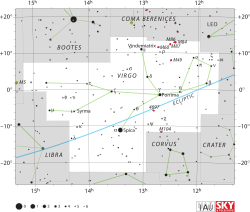Delta Virginis
| Observation data Epoch J2000 Equinox J2000 |
|
|---|---|
| Constellation | Virgo |
| Right ascension | 12h 55m 36.20861s |
| Declination | +3° 23′ 50.8932″ |
| Apparent magnitude (V) | 3.402 |
| Characteristics | |
| Spectral type | M3 III |
| U−B color index | +1.825 |
| B−V color index | +1.565 |
| Variable type | Semiregular |
| Astrometry | |
| Radial velocity (Rv) | –18.14 ± 0.55 km/s |
| Proper motion (μ) |
RA: –469.99 mas/yr Dec.: –52.83 mas/yr |
| Parallax (π) | 16.44 ± 0.22mas |
| Distance | 198 ± 3 ly (60.8 ± 0.8 pc) |
| Absolute magnitude (MV) | –2.4 ± 0.3 |
| Details | |
| Mass | 1.4 ± 0.3 M☉ |
| Radius | 48 R☉ |
| Luminosity | 468 L☉ |
| Surface gravity (log g) | 1.0 cgs |
| Temperature | 3,999 K |
| Metallicity [Fe/H] | –0.16 dex |
| Rotational velocity (v sin i) | 6.0 km/s |
| Other designations | |
| Database references | |
| SIMBAD | data |
Delta Virginis (δ Vir, δ Virginis) is a star in the zodiac constellation of Virgo. It has the traditional name Auva. With an apparent visual magnitude of 3.4, this star is bright enough to be seen with the naked eye. Based upon parallax measurements, it is located at a distance of about 198 light-years (61 parsecs) from Earth.
The spectrum of this star matches a stellar classification of M3 III, which places it among the category of evolved stars called red giants. Indeed, the outer atmosphere of this star has expanded to around 48 times the radius of the Sun. Even though it has just 1.4 times the mass of the Sun, this wide envelope gives it a luminosity of roughly 468 times the Sun's. This energy is being radiated from a relatively cool outer atmosphere that has an effective temperature of nearly 4,000 K. It is this cool temperature that gives it the orange-red glow of an M-type star.
The outer envelope of this star is undergoing a type of pulsation that occurs in a class of variable stars known as semiregular variables and its brightness varies from magnitude +3.32 to +3.40. Based upon frequency analysis of the observed light curve, the star's variability exhibits multiple periods of pulsation. The detected periods are 13.0, 17.2, 25.6, 110.1 and 125.8 days. This is a high-velocity star with a peculiar velocity of more than 30 km s−1 relative to the mean motion of other stars in the vicinity.
Delta Virginis is a possible binary star, as an 11th magnitude star is located at an angular separation of 80 arcseconds. This K-type dwarf may have an orbital period of over 200,000 years, but this has not been confirmed.
...
Wikipedia

